Optimization of Printing Parameters to Enhance Tensile Properties of ABS and Nylon Produced by Fused Filament Fabrication
Abstract
1. Introduction
| Material | Printed Parameters | Results | Ref |
|---|---|---|---|
| ABS |
| Young’s modulus for 0, 45, and 90 deg of printing orientation are 1.81 GPa, 1.80 GPa, and 1.78 GPa, respectively, while the ultimate strength values are 22.4, 20.7, and 19.0 MPa, respectively. | [26] |
| ABS |
| Elasticity modulus: 0.65 GPa, strength: 21.68 MPa. | [27] |
| ABS Nylon |
| ABS: elasticity modulus: 1.3 GPa, ultimate strength: 43 MPa. Nylon: elasticity modulus: 1.45 GPa, ultimate strength: 49 MPa. | [28] |
| ABS |
| Elasticity modulus: 1.3 GPa, ultimate strength: 34.5 MPa. | [30] |
| ABS |
| The infill density is the key process variable that affects ABS strength and elastic modulus, the layer thickness is the second, the raster angle is the third, and the printing speed is the last. | [33] |
| ABS |
| The optimum parameters are an 80% infill percentage, 0.5 mm layer thickness, and 65° raster angle. Tensile strength 31.57 MPa, elastic modulus 0.77 GPa, yield strength 19.95 MPa. | [34] |
| ABS |
| The best results were obtained with a concentric infill pattern, along with an 80% infill density and 100 μm layer thickness. Tensile strength 38.95 MPa, yield strength 30.07 MPa. | [35] |
| Nylon |
| At the infill density of 20–40%, neighboring tracks of the same layer do not touch each other. When it is increased to 60%, the parallel tracks make contact, which leads to the formation of a continuous layer, and increases the strength of the entire sample. | [37] |
| Nylon |
| The infill density is the most significant parameter. The number of contours is the second. The layer thickness ranks third. The number of shells is the fourth. The raster pattern has the lowest significance. The first four parameters control about 80% of the response value. | [38] |
| Nylon |
| The infill density has the highest contributing factor to mechanical characteristics, the layer thickness is second, and the printing speed is the last. | [13] |
| Nylon |
| The layer thickness is the significant primary variable for all responses. | [39] |
| ABS Nylon |
| For ABS, the tensile strength is max. for 0.2 mm layer thick, a 150 orient. angle, and 1.2 mm shell thickness. For nylon, the tensile strength is max. for 0.1 mm layer thick, a 300 orient. angle, and 1.2 mm shell thickness. | [40] |
2. Materials and Methods
2.1. Specimen Design
2.2. Design of Experiment
2.3. Experimental Procedure
2.4. Data Interpretation and Optimization
3. Results and Discussion
3.1. Experimental Results
3.2. Validation of Results
4. Conclusions
Author Contributions
Funding
Institutional Review Board Statement
Informed Consent Statement
Data Availability Statement
Conflicts of Interest
References
- Godec, D.; Gonzalez-Gutierrez, J.; Nordin, A.; Pei, E.; Ureña Alcázar, J. A Guide to Additive Manufacturing; Springer: Cham, Switzerland, 2022. [Google Scholar] [CrossRef]
- Formlabs. Guide to 3D Printing Materials: Types, Applications, and Properties. Available online: https://formlabs.com/blog/3d-printing-materials/ (accessed on 14 November 2021).
- Rouf, S.; Malik, A.; Singh, N.; Raina, A.; Naveed, N.; Siddiqui, M.I.H.; Haq, M.I.U. Additive manufacturing technologies: Industrial and medical applications. Sustain. Oper. Comput. 2022, 3, 258–274. [Google Scholar] [CrossRef]
- Swetham, T.; Reddy, K.M.; Huggi, A.; Kumar, M.N. A Critical Review on of 3D Printing Materials and Details of Materials used in FDM. Int. J. Sci. Res. Sci. Eng. Technol. 2017, 3, 353–361. [Google Scholar]
- Salem Bala, A.; bin Wahab, S.; binti Ahmad, M. Elements and Materials Improve the FDM Products: A Review. Adv. Eng. Forum 2016, 16, 33–51. [Google Scholar] [CrossRef]
- Popescu, D.; Zapciu, A.; Amza, C.; Baciu, F.; Marinescu, R. FDM process parameters influence over the mechanical properties of polymer specimens: A review. Polym. Test. 2018, 69, 157–166. [Google Scholar] [CrossRef]
- Dey, A.; Yodo, N. A Systematic Survey of FDM Process Parameter Optimization and Their Influence on Part Characteristics. J. Manuf. Mater. Process 2019, 3, 64. [Google Scholar] [CrossRef]
- Li, L.; Sun, Q.; Bellehumeur, C.; Gu, P. Composite modeling and analysis for fabrication of FDM prototypes with locally controlled properties. J. Manuf. Process. 2002, 4, 129–141. [Google Scholar] [CrossRef]
- Tao, Y.; Kong, F.; Li, Z.; Zhang, J.; Zhao, X.; Yin, Q.; Xing, D.; Li, P. A review on voids of 3D printed parts by fused filament fabrication. J. Mater. Res. Technol. 2021, 15, 4860–4879. [Google Scholar] [CrossRef]
- Solomon, I.J.; Sevvel, P.; Gunasekaran, J. A review on the various processing parameters in FDM. Mater. Today Proc. 2020, 37, 509–514. [Google Scholar] [CrossRef]
- Syrlybayev, D.; Zharylkassyn, B.; Seisekulova, A.; Akhmetov, M.; Perveen, A.; Talamona, D. Optimisation of Strength Properties of FDM Printed Parts—A Critical Review. Polymers 2021, 13, 1587. [Google Scholar] [CrossRef] [PubMed]
- Vicente, C.M.S.; Martins, T.S.; Leite, M.; Ribeiro, A.; Reis, L. Influence of fused deposition modeling parameters on the mechanical properties of ABS parts. Polym. Adv. Technol. 2020, 31, 501–507. [Google Scholar] [CrossRef]
- Ramesh, M.; Panneerselvam, K. Mechanical investigation and optimization of parameter selection for Nylon material processed by FDM. Mater. Today Proc. 2020, 46, 9303–9307. [Google Scholar] [CrossRef]
- Alafaghani, A.; Qattawi, A.; Alrawi, B.; Guzman, A. Experimental Optimization of Fused Deposition Modelling Processing Parameters: A Design-for-Manufacturing Approach. Procedia Manuf. 2017, 10, 791–803. [Google Scholar] [CrossRef]
- de Toro, E.V.; Sobrino, J.C.; Martínez, A.M.; Eguía, V.M. Analysis of the influence of the variables of the Fused Deposition Modeling (FDM) process on the mechanical properties of a carbon fiber-reinforced polyamide. Procedia Manuf. 2019, 41, 731–738. [Google Scholar] [CrossRef]
- Akhoundi, B.; Behravesh, A.H. Effect of filling pattern on the tensile and flexural mechanical properties of FDM 3D printed products. Exp. Mech. 2019, 59, 883–897. [Google Scholar] [CrossRef]
- Fernandez-Vicente, M.; Calle, W.; Ferrandiz, S.; Conejero, A. Effect of Infill Parameters on Tensile Mechanical Behavior in Desktop 3D Printing. 3D Print. Addit. Manuf. 2016, 3, 183–192. [Google Scholar] [CrossRef]
- Muhamedagic, K.; Berus, L.; Potočnik, D.; Cekic, A.; Begic-Hajdarevic, D.; Cohodar Husic, M.; Ficko, M. Effect of Process Parameters on Tensile Strength of FDM Printed Carbon Fiber Reinforced Polyamide Parts. Appl. Sci. 2022, 12, 6028. [Google Scholar] [CrossRef]
- Rezaeian, P.; Ayatollahi, M.R.; Nabavi-Kivi, A.; Razavi, S.M.J. Effect of printing speed on tensile and fracture behavior of ABS specimens produced by fused deposition modeling. Eng. Fract. Mech. 2022, 266, 108393. [Google Scholar] [CrossRef]
- Yu, Z.; Gao, Y.; Jiang, J.; Gu, H.; Lv, S.; Ni, H.; Wang, X.; Jia, C. Study on Effects of FDM 3D Printing Parameters on Mechanical Properties of Polylactic Acid. IOP Conf. Ser. Mater. Sci. Eng. 2019, 688, 033026. [Google Scholar] [CrossRef]
- Jia, N.; Fraenkel, H.A.; Kagan, V.A. Effects of moisture conditioning methods on mechanical properties of injection molded nylon 6. J. Reinf. Plast. Compos. 2004, 23, 729–737. [Google Scholar] [CrossRef]
- Rahim, T.N.A.T.; Abdullah, A.M.; Akil, H.M.; Mohamad, D.; Rajion, Z.A. The improvement of mechanical and thermal properties of polyamide 12 3D printed parts by fused deposition modelling. Express Polym. Lett. 2017, 11, 963–982. [Google Scholar] [CrossRef]
- Saharudin, M.S.; Hajnys, J.; Kozior, T.; Gogolewski, D.; Zmarzły, P. Quality of Surface Texture and Mechanical Properties of PLA and PA-Based Material Reinforced with Carbon Fibers Manufactured by FDM and CFF 3D Printing Technologies. Polymers 2021, 13, 1671. [Google Scholar] [CrossRef]
- Zárybnická, L.; Machotová, J.; Pagáč, M.; Rychlý, J.; Vykydalová, A. The effect of filling density on flammability and mechanical properties of 3D-printed carbon fiber-reinforced nylon. Polym. Test. 2023, 120, 107944. [Google Scholar] [CrossRef]
- Calignano, F.; Lorusso, M.; Roppolo, I.; Minetola, P. Investigation of the Mechanical Properties of a Carbon Fibre-Reinforced Nylon Filament for 3D Printing. Machines 2020, 8, 52. [Google Scholar] [CrossRef]
- Zhang, H. Characterization of Tensile, Creep, and Fatigue Properties of 3D Printed Acrylonitrile Butadiene Styrene. Master’s Thesis, Purdue University, West Lafayette, IN, USA, 2016. [Google Scholar] [CrossRef]
- Özsoy, K.; Ercetin, A.; Çevik, Z.A. Comparison of mechanical properties of PLA and ABS based structures produced by fused deposition modelling additive manufacturing. Eur. J. Sci. Technol. 2021, 27, 802–809. [Google Scholar] [CrossRef]
- Lay, M.; Thajudin, N.L.; Hamid, Z.A.; Rusli, A.; Abdullah, M.K.; Shuib, R.K. Comparison of physical and mechanical properties of PLA, ABS and nylon 6 fabricated using fused deposition modeling and injection molding. Compos. B Eng. 2019, 176, 107341. [Google Scholar] [CrossRef]
- Shabana, R.; Sarojini, J.; Vikram, K.A.; Lakshmi, V. Evaluating the mechanical properties of commonly used 3D printed ABS and PLA polymers with multi layered polymers. Int. J. Eng. Adv. Technol. 2019, 8, 2351–2356. [Google Scholar] [CrossRef]
- Kannan, S.; Ramamoorthy, M. Mechanical characterization and experimental modal analysis of 3D Printed ABS, PC and PC-ABS materials. Mater. Res. Express 2020, 7, 015341. [Google Scholar] [CrossRef]
- Salim, M.A.; Termiti, Z.H.; Saad, A.; Mekanikal, F.K.; Teknikal, U. Mechanical properties on ABS/PLA materials for geospatial imaging printed product using 3D printer technology. Ref. Modul. Mater. Sci. Mater. Eng. 2019. [Google Scholar] [CrossRef]
- Rodríguez-Panes, A.; Claver, J.; Camacho, A.M. The influence of manufacturing parameters on the mechanical behaviour of PLA and ABS pieces manufactured by FDM: A comparative analysis. Materials 2018, 11, 1333. [Google Scholar] [CrossRef]
- Algarni, M.; Ghazali, S. Comparative study of the sensitivity of PLA, ABS, PEEK, and PETG’s mechanical properties to FDM printing process parameters. Crystals 2021, 11, 995. [Google Scholar] [CrossRef]
- Samykano, M.; Selvamani, S.K.; Kadirgama, K.; Ngui, W.K.; Kanagaraj, G. Mechanical property of FDM printed ABS: Influence of printing parameters. Int. J. Adv. Manuf. Technol. 2019, 102, 2779–2796. [Google Scholar] [CrossRef]
- Agrawal, A.P.; Kumar, V.; Kumar, J.; Paramasivam, P.; Dhanasekaran, S.; Prasad, L. An investigation of combined effect of infill pattern, density, and layer thickness on mechanical properties of 3D printed ABS by fused filament fabrication. Heliyon 2023, 9, 6. [Google Scholar] [CrossRef] [PubMed]
- Venkatesh, R.; Britto, J.J.J.; Amudhan, K.; Anbumalar, V.; Prabhakaran, R.; Sakthi, R.T. Experimental investigation of mechanical properties on CF reinforced PLA, ABS and Nylon composite part. Mater. Today Proc. 2023, 76, 4. [Google Scholar] [CrossRef]
- Terekhina, S.; Skornyakov, I.; Tarasova, T.; Egorov, S. Effects of the infill density on the mechanical properties of nylon specimens made by filament fused fabrication. Technologies 2019, 7, 57. [Google Scholar] [CrossRef]
- Mostafa, K.G.; Montemagno, C.; Qureshi, A.J. Strength to cost ratio analysis of FDM Polyamide 12 3D Printed Parts Costing models capacity optimization in Industry between used capacity and operational efficiency. Procedia Manuf. 2018, 26, 753–762. [Google Scholar] [CrossRef]
- Moradi, M.; Aminzadeh, A.; Rahmatabadi, D.; Rasouli, S.A. Statistical and Experimental Analysis of Process Parameters of 3D Nylon Printed Parts by Fused Deposition Modeling: Response Surface Modeling and Optimization. J. Mater. Eng. Perform. 2021, 30, 5441–5454. [Google Scholar] [CrossRef]
- Vishwas, M.; Basavaraj, C.K.; Vinyas, M. Experimental Investigation using Taguchi Method to Optimize Process Parameters of Fused Deposition Modeling for ABS and Nylon Materials. Mater. Today Proc. 2018, 5, 7106–7114. [Google Scholar] [CrossRef]
- Vidakis, N.; Petousis, M.; Tzounis, L.; Maniadi, A.; Velidakis, E.; Mountakis, N.; Kechagias, J.D. Sustainable Additive Manufacturing: Mechanical Response of Polyamide 12 over Multiple Recycling Processes. Materials 2021, 14, 466. [Google Scholar] [CrossRef]
- Yankin, A.; Serik, G.; Danenova, S.; Alipov, Y.; Temirgali, A.; Talamona, D.; Perveen, A. Optimization of Fatigue Performance of FDM ABS and Nylon Printed Parts. Micromachines 2023, 14, 304. [Google Scholar] [CrossRef]
- Roy, R.K. A Primer on the Taguchi Method; Society of Manufacturing Engineers: Southfield, MI, USA, 2010; 290p. [Google Scholar]
- Verbeeten, W.M.; Arnold-Bik, R.J.; Lorenzo-Bañuelos, M. Print velocity effects on strain-rate sensitivity of acrylonitrile-butadiene-styrene using material extrusion additive manufacturing. Polymers 2021, 13, 149. [Google Scholar] [CrossRef]
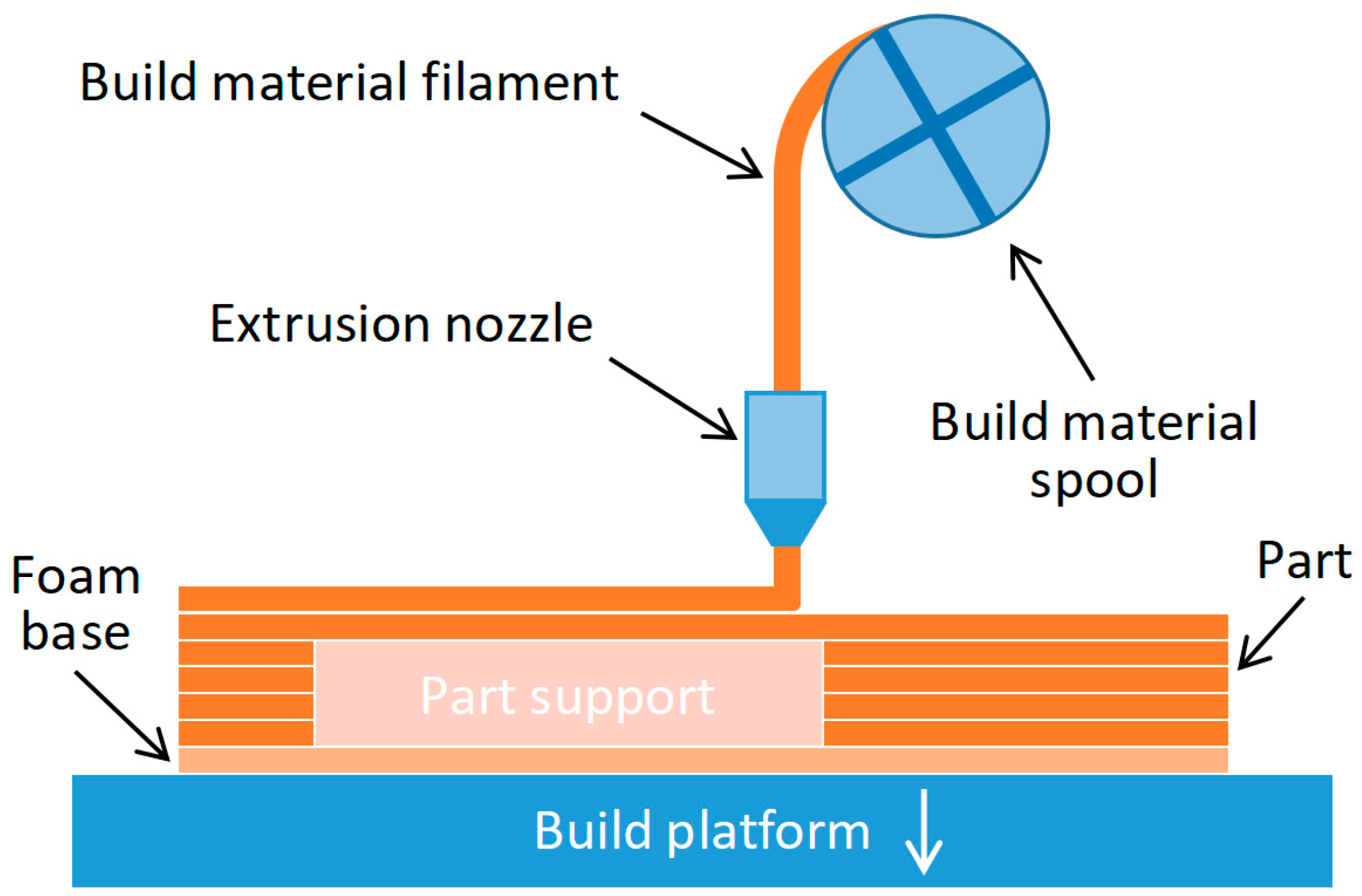
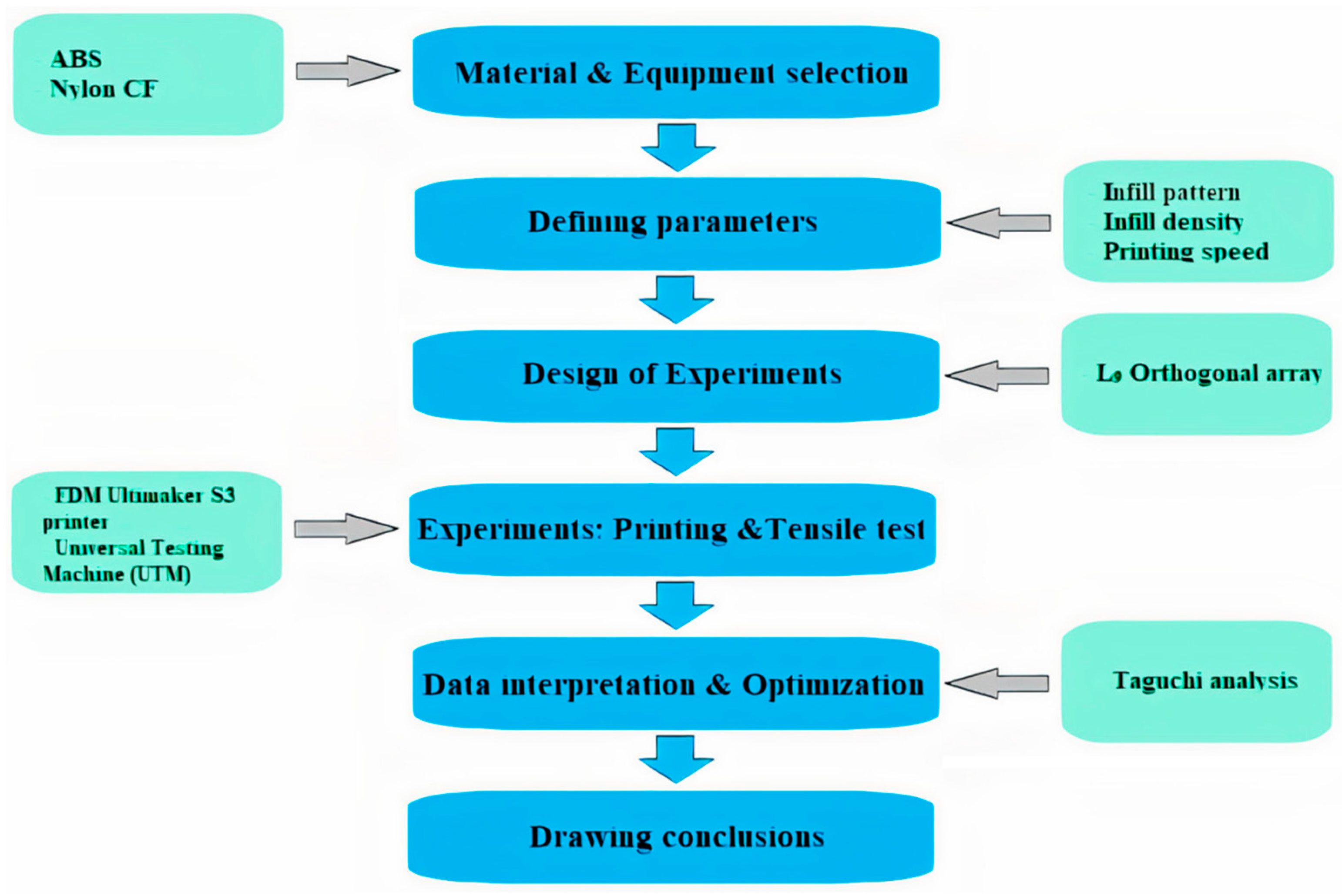


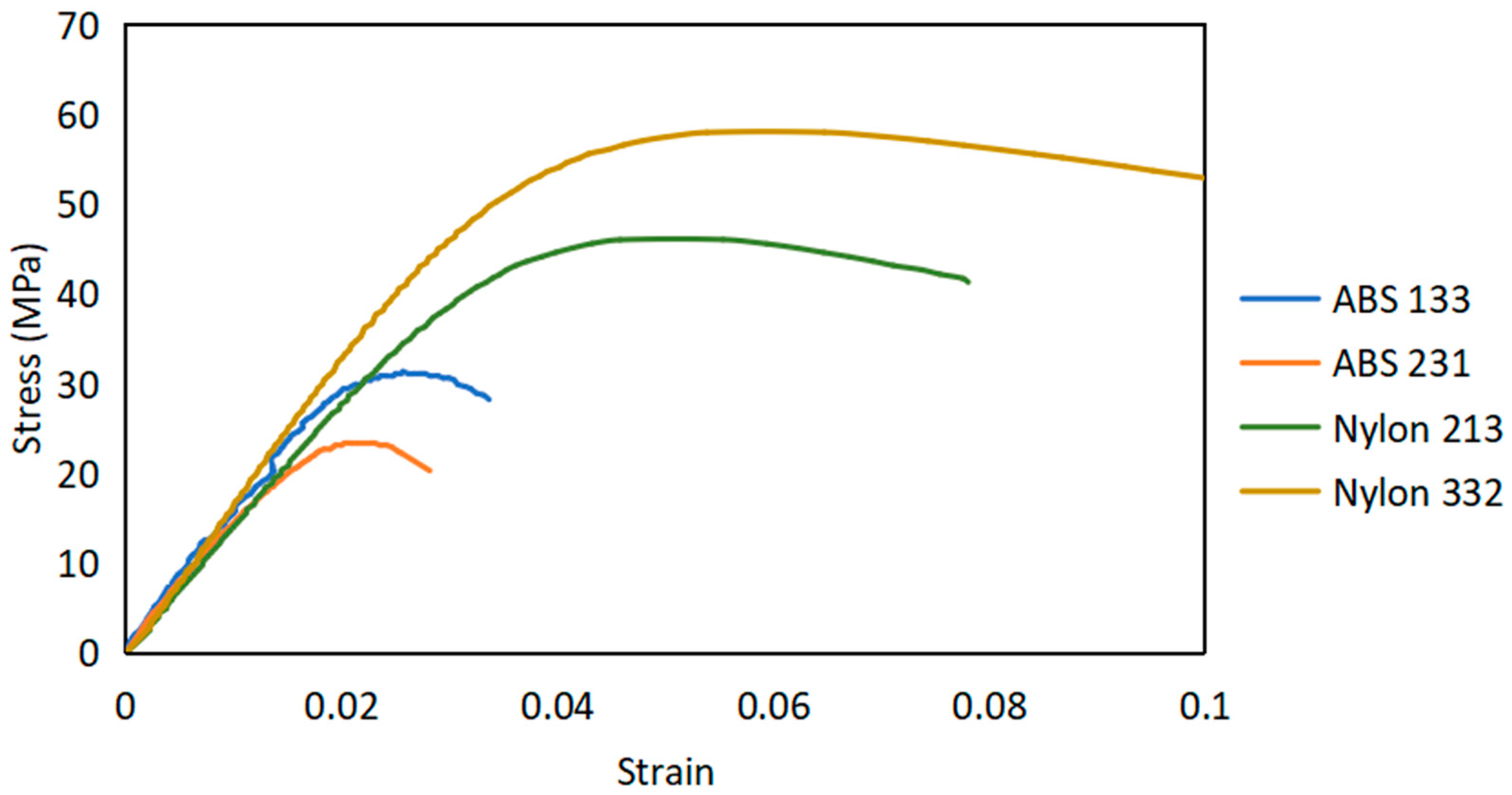
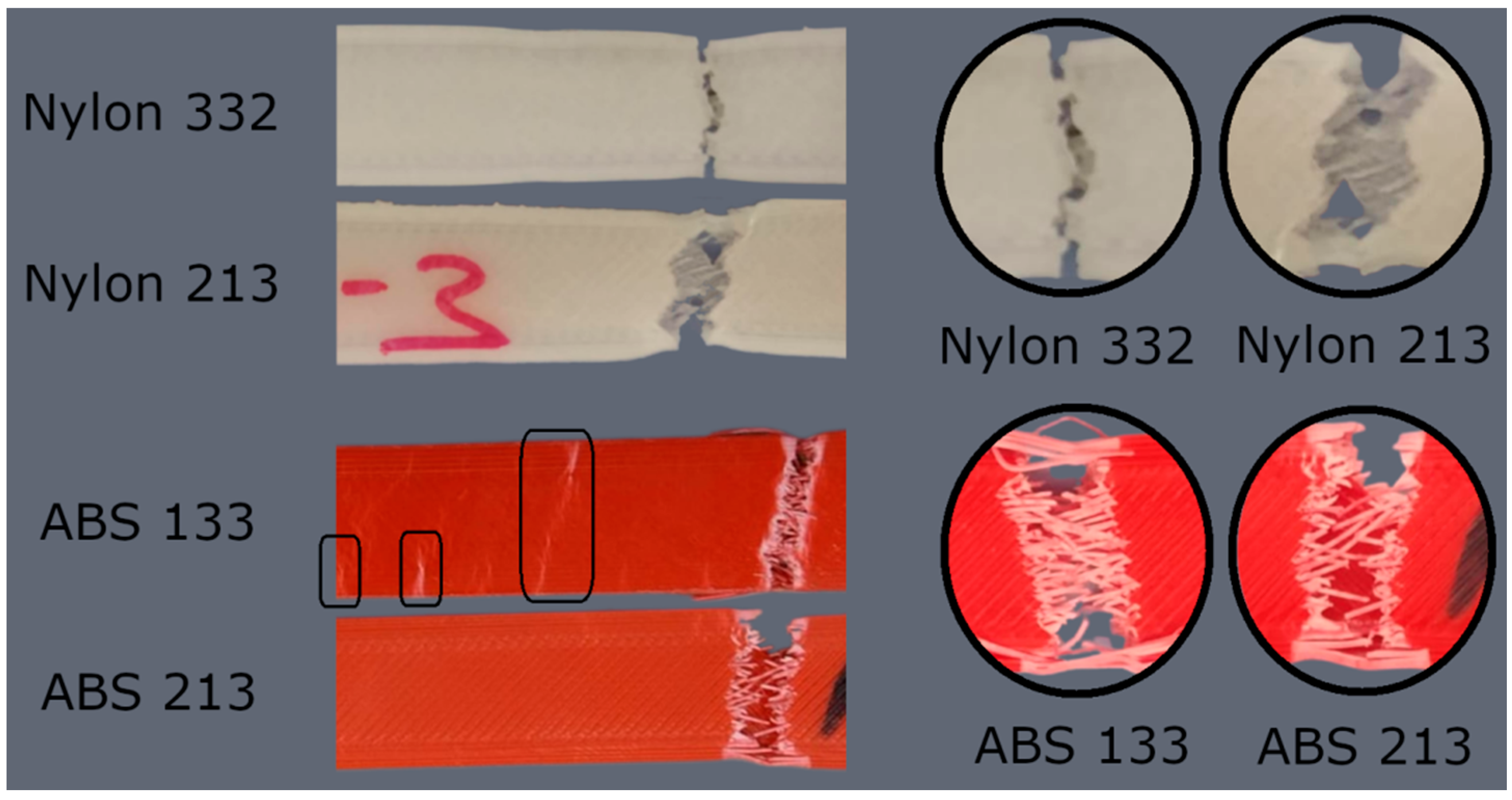


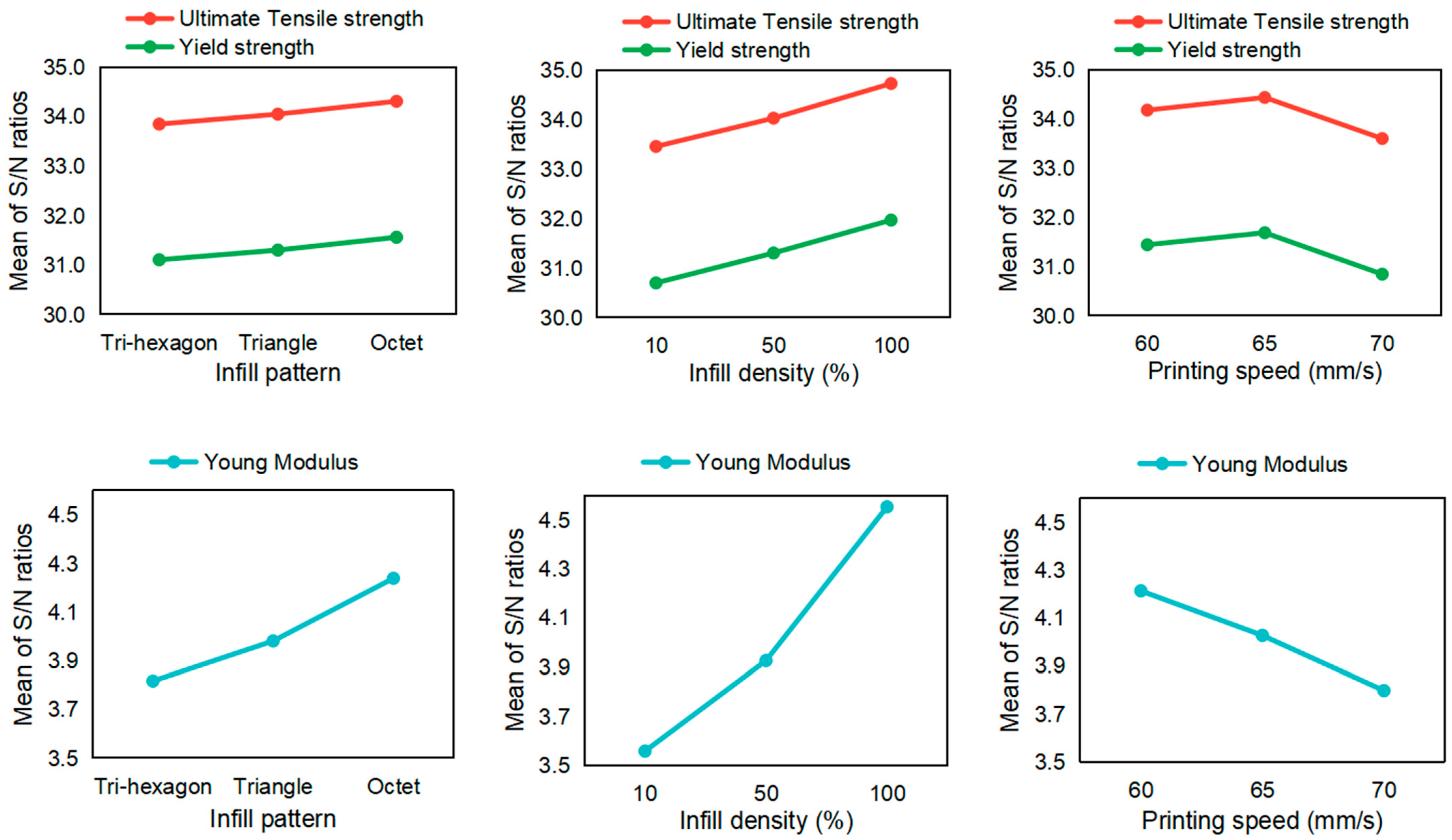
| Parameters | Level 1 | Level 2 | Level 3 |
|---|---|---|---|
| A: Infill pattern | Tri-hexagonal | Triangular | Octet |
| B: Infill density | 10% | 50% | 100% |
| C: Printing speed | 60 mm/s | 65 mm/s | 70 mm/s |
| # | A: Infill Pattern | B: Infill Density | C: Printing Speed |
|---|---|---|---|
| 1 | Tri-hexagonal | 10% | 60 mm/s |
| 2 | Tri-hexagonal | 50% | 65 mm/s |
| 3 | Tri-hexagonal | 100% | 70 mm/s |
| 4 | Triangular | 10% | 70 mm/s |
| 5 | Triangular | 50% | 65 mm/s |
| 6 | Triangular | 100% | 60 mm/s |
| 7 | Octet | 10% | 70 mm/s |
| 8 | Octet | 50% | 60 mm/s |
| 9 | Octet | 100% | 65 mm/s |
| Parameter | ABS | Nylon |
|---|---|---|
| Layer height | 0.15 mm | 0.15 mm |
| Orientation | horizontal | horizontal |
| Wall thickness | 1.3 mm | 1.3 mm |
| Wall line Count | 4 | 4 |
| Horizontal expansion | 0 mm | 0 mm |
| Top/bottom thickness | 1.2 mm | 1.2 mm |
| Top layers | 8 | 8 |
| Bottom layers | 8 | 8 |
| Nozzle diameter | 0.4 mm | 0.4 mm |
| Fan speed | 2% | 40% |
| Printing temperature | 240 °C | 245 °C |
| Test Code | Ultimate Tensile Strength, MPa | Young’s Modulus, GPa | Yield Strength, MPa | |||
|---|---|---|---|---|---|---|
| ABS | Nylon | ABS | Nylon | ABS | Nylon | |
| 111 | 26.1 | 47.2 | 1.61 | 1.50 | 23.6 | 34.4 |
| 122 | 30.6 | 51.0 | 1.63 | 1.52 | 28.2 | 37.3 |
| 133 | 31.3 | 49.6 | 1.67 | 1.63 | 29.0 | 36.1 |
| 213 | 23.3 | 46.1 | 1.55 | 1.44 | 20.8 | 33.5 |
| 222 | 28.3 | 49.4 | 1.58 | 1.57 | 25.2 | 36.1 |
| 231 | 30.3 | 56.2 | 1.72 | 1.75 | 27.0 | 41.0 |
| 313 | 24.9 | 47.9 | 1.52 | 1.58 | 23.3 | 35.0 |
| 321 | 27.6 | 50.4 | 1.60 | 1.63 | 24.6 | 36.9 |
| 332 | 30.6 | 58.0 | 1.61 | 1.68 | 27.3 | 42.1 |
| S/N Ratios | Parameter Level | Infill Pattern | Infill Density | Printing Speed |
|---|---|---|---|---|
| Ultimate tensile strength | 1 | 29.32 | 27.87 | 28.93 |
| 2 | 28.67 | 29.19 | 29.49 | |
| 3 | 28.82 | 29.75 | 28.39 | |
| Delta | 0.65 | 1.88 | 1.09 | |
| Rank | 3 | 1 | 2 | |
| Young’s modulus | 1 | 4.28 | 3.85 | 4.30 |
| 2 | 4.16 | 4.11 | 4.12 | |
| 3 | 3.94 | 4.42 | 3.96 | |
| Delta | 0.34 | 0.57 | 0.34 | |
| Rank | 2 | 1 | 2 | |
| Yield strength | 1 | 28.56 | 27.04 | 27.96 |
| 2 | 27.67 | 28.29 | 28.59 | |
| 3 | 27.96 | 28.86 | 27.64 | |
| Delta | 0.89 | 1.82 | 0.95 | |
| Rank | 3 | 1 | 2 |
| S/N Ratios | Parameter Level | Infill Pattern | Infill Density | Printing Speed |
|---|---|---|---|---|
| Ultimate tensile strength | 1 | 33.85 | 33.45 | 34.17 |
| 2 | 34.05 | 34.02 | 34.43 | |
| 3 | 34.31 | 34.72 | 33.60 | |
| Delta | 0.46 | 1.27 | 0.83 | |
| Rank | 3 | 1 | 2 | |
| Young’s modulus | 1 | 3.82 | 3.56 | 4.21 |
| 2 | 3.98 | 3.93 | 4.03 | |
| 3 | 4.24 | 4.55 | 3.80 | |
| Delta | 0.42 | 0.99 | 0.42 | |
| Rank | 2 | 1 | 2 | |
| Yield strength | 1 | 31.10 | 30.70 | 31.44 |
| 2 | 31.30 | 31.30 | 31.68 | |
| 3 | 31.56 | 31.97 | 30.84 | |
| Delta | 0.46 | 1.27 | 0.84 | |
| Rank | 3 | 1 | 2 |
| Material | Best Configuration Parameters | Comparison to Other Configuration Results | ||
|---|---|---|---|---|
| Parameter 1 | Parameter 2 | Parameter 3 | ||
| ABS | Tri-hexagon geometric structure | 100% infill density | 65 mm/s printing speed | Highest |
| Nylon | Octet geometric structure | 100% infill density | 65 mm/s printing speed | The same, with the second-highest configuration |
Disclaimer/Publisher’s Note: The statements, opinions and data contained in all publications are solely those of the individual author(s) and contributor(s) and not of MDPI and/or the editor(s). MDPI and/or the editor(s) disclaim responsibility for any injury to people or property resulting from any ideas, methods, instructions or products referred to in the content. |
© 2023 by the authors. Licensee MDPI, Basel, Switzerland. This article is an open access article distributed under the terms and conditions of the Creative Commons Attribution (CC BY) license (https://creativecommons.org/licenses/by/4.0/).
Share and Cite
Yankin, A.; Alipov, Y.; Temirgali, A.; Serik, G.; Danenova, S.; Talamona, D.; Perveen, A. Optimization of Printing Parameters to Enhance Tensile Properties of ABS and Nylon Produced by Fused Filament Fabrication. Polymers 2023, 15, 3043. https://doi.org/10.3390/polym15143043
Yankin A, Alipov Y, Temirgali A, Serik G, Danenova S, Talamona D, Perveen A. Optimization of Printing Parameters to Enhance Tensile Properties of ABS and Nylon Produced by Fused Filament Fabrication. Polymers. 2023; 15(14):3043. https://doi.org/10.3390/polym15143043
Chicago/Turabian StyleYankin, Andrei, Yerassyl Alipov, Ali Temirgali, Gaini Serik, Saniya Danenova, Didier Talamona, and Asma Perveen. 2023. "Optimization of Printing Parameters to Enhance Tensile Properties of ABS and Nylon Produced by Fused Filament Fabrication" Polymers 15, no. 14: 3043. https://doi.org/10.3390/polym15143043
APA StyleYankin, A., Alipov, Y., Temirgali, A., Serik, G., Danenova, S., Talamona, D., & Perveen, A. (2023). Optimization of Printing Parameters to Enhance Tensile Properties of ABS and Nylon Produced by Fused Filament Fabrication. Polymers, 15(14), 3043. https://doi.org/10.3390/polym15143043







